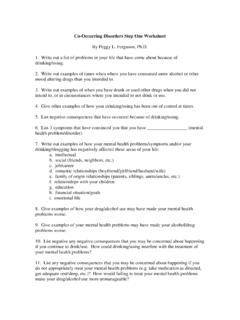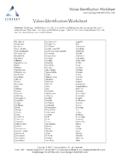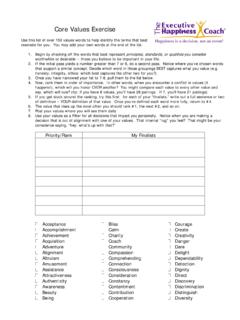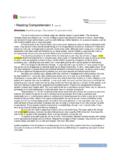Transcription of TIPS & SUGGESTIONS FOR USE IN THE DIFFERENT STAGES ...
1 TIPS & SUGGESTIONS FOR USE IN THE DIFFERENT STAGES precontemplation : during this stage , it s not that the sufferer can t see the solution to his/her problem they can t see the problem. When pre-contemplators enter therapy, they often do so because of pressure from others. They may even demonstrate change as long as the pressure is on. Once the pressure is off, however, they often quickly return to their old ways. Pre-contemplators can, at times, want to change but this seems to be quite DIFFERENT from intending or seriously considering change in the next six months, for example. Resistance to recognizing or modifying a problem is the hallmark of precontemplation . precontemplation do s and don ts are: DO S: Try to connect with the person, talk about current affairs or any non eating disorder subjects.
2 Spend time doing things you both enjoy. Try to be non-judgmental and remain warm and accepting, yet have firm personal boundaries and limits. Try not to reason logically with the eating disorder this does not work. At worse, it strengthens the person s beliefs and arguments for remaining stuck in the eating disorder. Try and give other family members time. Try not to get into endless cycles of reassurance as this does not actually help the sufferer. Try to understand why staying in the eating disorder is so important to them. Look after yourself. Maintain your own interests and life and encourage the rest of the family to do the same. Try to have short breaks. Objectivity: provide feedback about their health connecting the eating disorder and its consequences ( feeling cold, tired, lacking concentration, withdrawing socially, looking unhappy etc).
3 Educate: leaflets, books, self help, treatments and outcomes. Find medical and nutritional information ( building bones and the nutrition they need). Separate the person from the eating disorder the anorexia minx, gremlin etc. Remember to praise the non eating disorder activities. Notice and value any small, positive changes. DON TS: Remember at the precontemplation stage , any arguments for change from you will result in more resistance from the person and they will have the opportunity to rehearse stronger arguments to stay the same (no direct advice or SUGGESTIONS from you but indirect other people tell me , books have you noticed Remember that conflict can make it harder for the person to talk about their worries.)
4 Don t argue with logic. Don t give advice or try and fix the person Don t use why questions Contemplation: this is the stage in which people are aware that a problem exists and are seriously thinking about overcoming it but have not yet made a commitment to take action. Sufferers can remain in the contemplation stage for long periods, knowing where they want to go but not quite ready yet. Serious consideration of problem resolution is the central element of contemplation. Strategies for this stage include: Help person generate list of pros and cons of change. Keep making connection between eating disorder and consequences. Explore difficulties in change alternative strategies? What would be difficult? What alternative strategies can they explore?
5 Discuss possible plans of action. Encourage talk about the negative consequences of the eating disorder when it occurs. Focus on choices rather than give advice. Preparation/determination: is the stage that combines intention and behaviour criteria. Individuals in this stage usually intend to take imminent action and have unsuccessfully taken action in the past year. Preparation do s include: Ask the person if they would like your help to make a concrete plan for symptom reduction or if they would like to include you in their plan in some way. What do they find unhelpful? What do they find helpful? What would success look like having a clear set of goals can be very helpful? How will the person know if they are achieving their aims?
6 How will they monitor this? Help them to think of all the support that is available to them and explore realistically what might make it hard to use the support. What is their Plan B? Try not to enable them to be ill ( allowing them to turn the heating up whilst the house is warm enough already). Continue to help them explore the difficulties if change were to occur. What strategies could help the person deal with difficulties? You could help them explore and practice these. Action is the stage in which individuals modify their behaviour, experiences or environment in order to overcome their problems. Action involves the obvious behaviour changes and requires considerable commitment of time and energy.
7 People, including professionals, often wrongly equate action with change. As a consequence, they overlook the requisite work that prepares changers for action and the important efforts necessary to maintain the changes following action. Modification of the target behaviour to a manageable and repeatable action through significant obvious efforts to change are the hallmarks of action. Action do s include:- Offer to help them learn new strategies for coping with feelings and urges to engage in old habits. Review and learn from past relapses. Make a list of signs of relapses. Explore how things have worked in the past. Explore difficulties as change occurs and make contingency plans. Assist with problem solving.
8 Allow the person to take risks, set tasks, goals broken down into steps, minimize sick role, encourage independence, encourage patient s use of skills, set clear limits, remind them every mistake is the opportunity to learn, and that action does not always lead to successful change. Help them to tolerate small steps . Attend to creeping signs of denial. Ask if they have noticed any benefits from the small changes they have been making. Praise their efforts and intentions to change. Maintenance is the stage in which people work to prevent or tolerate relapse and consolidate the gains attained during action and is a continuation of change. Maintenance do s: Have a list of signs of relapse. Provide support and encourage coping skills.
9 Reinforce their bonds with support resources. Watch for creeping denial. Encourage new healthy interests. Encourage more independence. Relapse The spiral model suggests that most people who relapse do not revolve endlessly in circles and that they do not regress all the way back to where they began. time a relapse occurs, people recycle through the STAGES , they potentially learn from their mistakes and can try something DIFFERENT the next time around. Relapse do s include: Review what has been learned. Encourage and maintain new perspectives. Maintain positive attitude. Regard relapse as part of the learning process.






